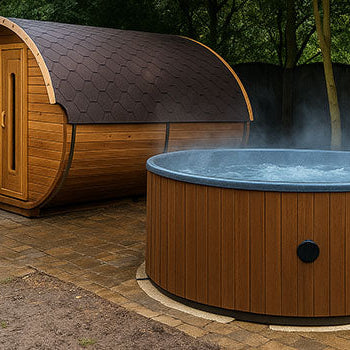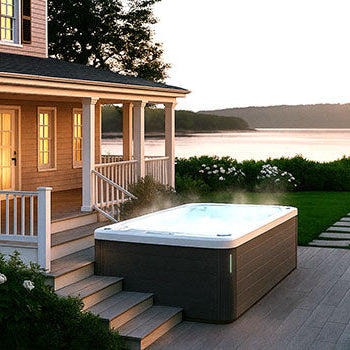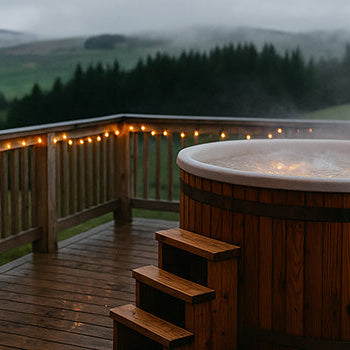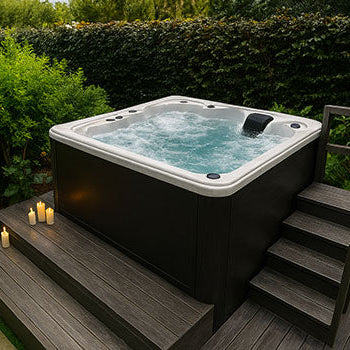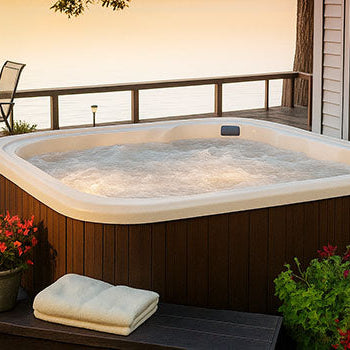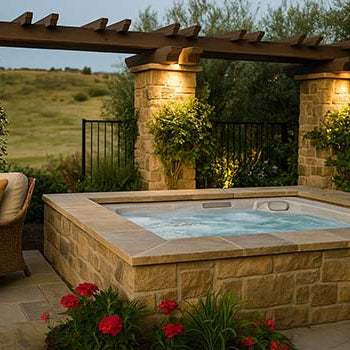How much should you really spend on a hot tub? Short answer: between £3,000 and £15,000, depending on what you want out of it. Some prefer a simple soak under the stars, others want full-on spa luxury in the garden.
Maybe you’re drawn to acrylic tubs with built-in tech, or leaning towards a wood-fired wooden tub for that rustic vibe. Rotomoulded models sit somewhere in the middle, tough and no-fuss.
If you're unsure what fits your lifestyle (and wallet), stick around. We’re breaking it down by price, quality, and how not to overpay for bubbles.

UK Hot Tub Market Overview: Price Tiers Explained
Below £1,000: Inflatable Hot Tub Options
Inflatable hot tubs are the inflatable flamingo of the spa world; fun, affordable, and easy to store.
These cost under £1,000, sometimes even £400, and are perfect for summer evenings with friends or an occasional dip after work. But be realistic: they’re not built for long-term use or harsh winters.
Expect basic bubbles, slow heating times, and a shorter lifespan. Great for beginners, but not a forever tub.
£3,000 - £6,000: Entry-Level Hard Shell Spas
Here’s where you level up. These entry-level hard shell tubs come in acrylic or rotomoulded finishes and offer far better insulation, structure, and comfort than inflatable options.
You’ll typically get 20–30 jets, seating for 4–5 people, and a basic filtration system. It’s a noticeable step up for regular soaking.
They’re ideal for families or couples wanting the real hot tub experience, without going all-in on luxury.
£6,000 - £10,000: Mid-Range Models (The Popular Choice)
This is the sweet spot for most UK buyers. Mid-range tubs often include upgraded jet systems, contoured seats, mood lighting, and energy-saving insulation.
Expect more durable builds, better filtration, and features like waterfall effects or Bluetooth speakers. You’ll even find some traditional wooden tubs in this price range, especially if handcrafted.
It’s where comfort, features, and cost start to balance out.
£10,000 - £15,000: Premium Features and Build Quality
Now you’re getting into serious spa territory. These models are designed for wellness, daily use, and long-term savings on energy bills.
You’ll find smart controls, touchscreen panels, water care systems, and high-end lighting. Build quality is top-tier, and the materials reflect it, from heavy-duty acrylic shells to weather-resistant frames.
These tubs offer the kind of hydrotherapy that actually makes a difference to your body and mind.
£15,000+: Luxury and High-Performance Hot Tubs
At this point, you’re shopping for more than a hot tub, you’re investing in a lifestyle.
These models come with 100+ jets, built-in audio systems, TV displays, saltwater sanitising, and even lounge-style recliners. Expect advanced insulation, extended warranties, and stunning finishes.
If you want the best of everything (and never want to upgrade again), this is where you’ll land.
What Factors Influence the Price Tag?
Size, Seating, and Water Capacity
It’s simple: more people = more tub.
A hot tub for two won’t cost the same as a party-size spa with seven seats and a lounger. Larger tubs use more materials, more water, and bigger pumps, so they also cost more to heat and run.
Choose the right size for how you’ll actually use it, not just what looks impressive online.
Shell Construction Materials and Techniques
The shell is the heart of your hot tub, and it shows in the price.
Acrylic tubs are sleek and durable, perfect for long-term use. Rotomoulded models are tougher and usually more affordable, but less refined in design. Wooden hot tubs offer charm and a traditional look, but need more care.
The better the material, the longer it’ll last (and the better it’ll look over time).
Hydrotherapy Jets: Quantity, Quality, and Variety
It’s not just how many jets you have, it’s what they do.
Budget tubs offer basic bubble action, while premium ones deliver real muscle therapy with targeted, adjustable massage jets. Some even have foot and neck jets for full-body relief.
If you want recovery, not just relaxation, jet design really matters.
Insulation Levels and Energy Efficiency Credentials
Insulation is where short-term savings can lead to long-term costs, or vice versa.
Basic models often have little insulation, meaning your heater works overtime. Premium tubs feature full foam or multi-layer insulation, saving hundreds per year on bills.
If you're using your tub regularly, this is a key feature to prioritise.
Advanced Water Purification Systems (Ozone, UV, Salt)
Water care can be hands-on… or hands-off.
Basic models need frequent chemical balancing. More advanced tubs offer ozone, UV, or salt systems that reduce manual maintenance and keep water cleaner, longer.
Less faff, more soaking.
Controls, Connectivity, Lighting, and Audio Features
Want to preheat your spa on your way home from work? That’s where Wi-Fi controls and smart apps come in.
Features like LED lighting, waterfall effects, and Bluetooth speakers add to the atmosphere, but also increase the cost. Choose the extras you’ll actually use, not just what looks cool in a showroom.
Manufacturer Reputation, Warranty, and Dealer Support
A cheaper hot tub from a no-name brand may not come with long-term support.
Look for a strong warranty, clear service promises, and UK-based support. A well-known brand often offers better peace of mind if something breaks or needs replacing.
You’re buying a product and a backup plan.

Features and Quality: What Your Money Buys at Each Level
Expectations for Entry-Level Hot Tubs
-
10–25 basic jets
-
Manual control panels
-
Limited insulation
-
Basic filtration system
-
Short-term warranties
-
Simple moulded seating
They’re functional, but don't expect the bells and whistles.
Common Upgrades in Mid-Range Spas
-
Ergonomic seating and more powerful massage
-
Upgraded water filtration
-
Partial or full foam insulation
-
Mood lighting and basic audio
-
User-friendly digital controls
These tubs are built for weekly or daily use with much more comfort.
Hallmarks of Premium and Luxury Hot Tubs
-
50–100+ therapeutic jets
-
Full-body massage seats
-
Smart control systems (apps, remotes, touchscreen)
-
Ozone, UV, or saltwater sanitisation
-
Designer lighting, waterfalls, and sound systems
-
Long warranties and robust build quality
This is the closest you’ll get to a professional spa, without leaving your home.
Finding Your Budget "Sweet Spot" for a Good Hot Tub
Defining Your Priorities: What Does "Good" Mean to You?
“Good” is personal. For some, it’s low maintenance. For others, it’s hydrotherapy that eases back pain or a place to gather friends on weekends.
Make a list of what matters most, then match that to the features that support those goals.
Balancing Upfront Cost with Long-Term Value and Running Costs
That cheaper tub may seem like a bargain, until you see the energy bill.
Better insulation, efficient heating, and modern filtration pay off in the long run. Sometimes, spending £1,000 more upfront can save you twice that over five years.
Think like an investor, not just a buyer.
Factoring in Installation and Ongoing Expenses
Beyond the tub itself, budget for:
-
Electrical work (£300–£750)
-
A solid base or platform
-
Chemicals and water treatments
-
Filter replacements
-
Potential repairs and service fees
It adds up, but planning ahead avoids surprise costs.
Researching Reputable Brands Within Your Budget
Don’t fall for big discounts with no reviews or support history.
Stick to brands with good reputations, solid aftercare, and honest advice. Local showrooms are a great place to try before you buy and ask all the awkward questions.
It’s your money, protect it.
Financing Your Hot Tub Purchase in the UK
Understanding Dealer Finance Offers (Including 0% APR)
Many hot tub dealers in the UK offer payment plans. The most popular? 0% APR over 12 to 48 months.
You’ll need a deposit, but these plans make premium tubs more affordable without racking up interest. Just read the fine print carefully.
Alternative Funding Routes
If dealer finance isn’t your thing, you can explore:
Just be sure to compare terms and only borrow what fits comfortably in your budget.

Conclusion: Investing the Right Amount for Your Needs
A good hot tub isn’t always the most expensive one, it’s the one that fits your life.
Most UK buyers find the best value between £5,000 and £10,000, balancing comfort, features, and efficiency. From rugged rotomoulded models to stylish wooden tubs and tech-filled acrylic spas, there’s something out there for every style and budget.
Don’t forget the extras: installation, running costs, and long-term support. Focus on what matters most to you, relaxation, therapy, social time, and let that guide your spend.
A good hot tub should make you feel better, not stressed about money.
